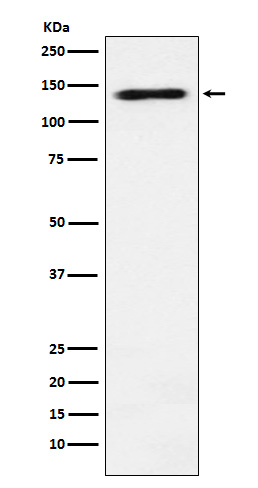
| WB | 1/500-1/1000 | Human,Mouse,Rat |
| IF | 咨询技术 | Human,Mouse,Rat |
| IHC | 1/50-1/100 | Human,Mouse,Rat |
| ICC | 1/50-1/200 | Human,Mouse,Rat |
| FCM | 1/50-1/100 | Human,Mouse,Rat |
| Elisa | 咨询技术 | Human,Mouse,Rat |
| Aliases | LKP; RHA; DDX9; NDH2; NDHII |
| Entrez GeneID | 1660 |
| WB Predicted band size | Calculated MW: 141 kDa; Observed MW: 141 kDa |
| Host/Isotype | Rabbit IgG |
| Antibody Type | Primary antibody |
| Storage | Store at 4°C short term. Aliquot and store at -20°C long term. Avoid freeze/thaw cycles. |
| Species Reactivity | Human,Mouse,Rat |
| Immunogen | A synthesized peptide derived from human RNA Helicase A |
| Formulation | Purified antibody in PBS with 0.05% sodium azide. |
+ +
以下是关于RNA Helicase A(DHX9/RHA)抗体的3篇参考文献,涵盖其功能研究和应用:
---
1. **文献名称**: **"RNA helicase A interacts with RISC in human cells and functions in miRNA processing"**
**作者**: Zhang H, et al.
**摘要**: 该研究利用RNA Helicase A特异性抗体进行免疫共沉淀(Co-IP)和Western blot分析,揭示了RNA Helicase A与RNA诱导沉默复合体(RISC)的相互作用,并证明其在miRNA成熟过程中的关键作用,尤其在Dicer介导的pre-miRNA剪切中不可或缺。
---
2. **文献名称**: **"DHX9 integrates innate immune signaling and regulates interferon-stimulated gene expression"**
**作者**: Lee KG, et al.
**摘要**: 通过免疫荧光(IF)和染色质免疫沉淀(ChIP)技术,该研究发现RNA Helicase A(DHX9)通过识别病毒RNA并激活MAVS信号通路,参与先天免疫应答,同时调控干扰素刺激基因(ISGs)的表达,抗体被用于验证其亚细胞定位及信号传导机制。
---
3. **文献名称**: **"RNA helicase A is essential for hepatitis C virus replication and associates with viral replication complexes"**
**作者**: Nishikawa T, et al.
**摘要**: 研究利用RNA Helicase A抗体进行免疫印迹和免疫荧光实验,证实DHX9与丙肝病毒(HCV)复制复合体结合,并通过siRNA敲低实验证明其对HCV RNA复制至关重要,提示其作为抗病毒治疗靶点的潜力。
---
这些文献均通过特异性抗体阐明了RNA Helicase A在RNA代谢、免疫调控及病毒复制中的多重功能,方法学涵盖Western blot、免疫沉淀及免疫荧光等经典技术。
RNA Helicase A (RHA/DHX9) is a multifunctional protein belonging to the DEAH-box helicase family, involved in transcriptional regulation, RNA processing, and innate immune responses. It unwinds double-stranded RNA/DNA structures and participates in processes like transcription elongation, mRNA splicing, and viral RNA sensing. Antibodies targeting RHA are essential tools for studying its roles in gene expression, cellular stress responses, and disease mechanisms, including cancer and viral infections.
RHA antibodies are typically raised against specific epitopes, such as the N-terminal dsRNA-binding domains or the C-terminal helicase region. These antibodies (polyclonal or monoclonal, from hosts like rabbit or mouse) are validated for applications including Western blotting, immunoprecipitation, immunofluorescence, and chromatin immunoprecipitation (ChIP). They help detect RHA's subcellular localization (nucleus/cytoplasm shuttling) and interactions with partners like RNA polymerase II or viral proteins.
Research using RHA antibodies has elucidated its involvement in HIV replication (via Rev-RRE interaction), neurodevelopmental disorders, and cancer progression, where RHA overexpression correlates with poor prognosis. Specific antibody clones (e.g., anti-DHX9 from Abcam or Santa Cruz Biotechnology) are widely used to study RHA's role in resolving R-loops, modulating miRNA biogenesis, and responding to interferon signaling. Validation often includes siRNA knockdown controls or recombinant protein assays to ensure specificity, given structural similarities among DEAD-box helicases. Commercial availability and consistent performance make these antibodies critical for dissecting RHA's diverse functions in molecular and pathological contexts.
×